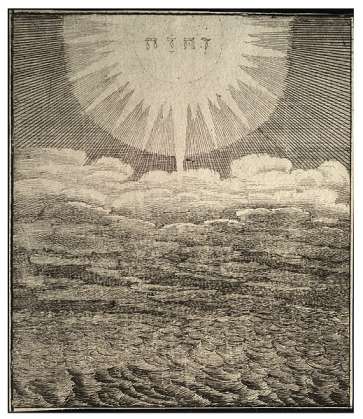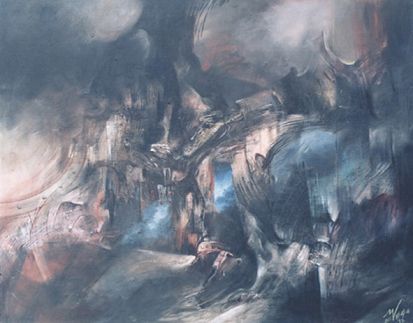Tartarus was considered the lowest point on earth. He is one of the protogenoi (first-born deities) as he arose from Chaos just like Gaia. Tartarus was the second entity to come into existence, and shortly after his birth he settled in the deepest bosom of the Earth – Gaia with the wide paths. Dark, devoid of life, and dismal, he is renowned for his guests/captives. His symbols are darkness, death as well as his namesake underworld.
Key Facts
Family tree
| Parents | None (appeared from within Chaos) |
| Partner(s) | Gaia |
| Siblings | None |
| Offspring | Typhon and Echidna |
Names & Others
| Roman Name | Tartarus |
| Other Names | Tartaros, Tartara |
| Ancient Greek | Τάρταρος |
| The God of | Abyss, captivity, darkness, death, and the underworld |
| Symbols | Captivity, darkness, death, and the underworld |
Tartarus’ Origins

Out of nothing came the Great Void otherwise called Chaos (Chasm). From Chaos, Gaia (Earth) arose and then Tartarus emerged. He didn’t speak or create anything but rushed into the broad courses of the deepest parts of the Earth and there made his eternal abode. In some sources, he is the son of Aether and Gaia while specifically in the Orphic texts Tartarus is the limitless, first-ever entity out of which the light and the cosmos come into being.
Tartarus in the Greek mythology
location
Although very little to none is revealed from the old texts about Tartarus as a deity there is quite a lot information regarding Tartarus as a place. Hesiod states that an anvil that falls from the top of the sky would require nine days and nine nights to reach the earth. In comparison, the same anvil would need another nine days to get from earth to Tartarus. Homer and Apollodorus describe it as being a gloomy region located as far under the surface of the earth as the highest point of the sky is above earth.
Tartarus is an ancient deity and more so a place older and wider than Hades’ underworld. Hades or Pluton, brother of Zeus, is the king of the underworld, also named Hades, and the god of the dead. Yet, Tartarus is further down in the deep, far below Hades and his deathly realm.
Tartarus’ prison
Before Hades was even born, Tartarus was the stage of great suffering and anguish. Uranus was the first to establish Tartarus as a dungeon fit for divine creatures such as his children, the one-eyed Cyclopes and the one hundred-armed Hecatoncheires, The Hundred-Handed Giants.
When Uranus was dethroned by his son, the Titan Cronus, the Cyclopes, One-Eyed Giant Monsters and Hecatoncheires were released from their prison. Their freedom however was short-lived as Cronus imprisoned them again in Tartarus fearing for his reign over the world. Not only that, but he put a dragon-like monster named Campe to stand guard at the gates of Tartarus.
This didn’t last long as the great Zeus fought and killed Campe and set the Cyclopes and the Hecatoncheires free again. The released creatures showed their gratitude by helping Zeus and the other Olympians to defeat Cronus and the Titans. Soon after the war had ended, the Hecatoncheires were placed as guardians of Tartarus and its new prisoners, the Titans.
Typhon and Echidna
Before the smoke of the Gigantomachy conflict had settled, Gaia sought to punish Zeus for his audacity of locking away the Titans in Tartarus. Sympathizing for her tormented offspring, Gaia mated with Tartarus. She then gave birth to one of the strongest and most fearsome entities in Greek mythology. No other than the giant dragon that breathed fire, Typhon, a monstrous serpentine giant.
Zeus was nearly killed by Typhon, but in the end, the glorious king of the gods overpowered the terrible dragon and cast him too down to Tartarus. But, that was not the only offspring that came from the union between Tartarus and Gaia. The gruesome Echidna, The Mother of Monstrous was also brought to life and together with Typhon, she gave birth to many famous monsters of Greek mythology.
Inhabitants
Apart from the defeated Titans and the crippled Typhon, there were many other figures confined within Tartarus’ vast and sunless halls. A unique and damned place of imprisonment and torment for those who had committed hubris against the gods Tartarus also became a synonym for condemnation and eternal punishment.

Mortal kings and common folk were sent there after their death. There to be sentenced to an eternity of anguish and torture befitting their heinous crimes. A few of the illustrious ‘guests’ included:
Sisyphus, the crafty king of Corinth, who after cunningly cheated death a few times, was ultimately condemned for eternity to try to get a boulder up to the top of a hill. Yet, each time he thought he was close the rock would always roll back down.
King Tantalus, The Demigod Forever Thirsting for Redemption, who killed his son and stole the food of the gods, was to forever stand in a pool of water under a tree full of fruits. Then whenever he attempted to take one to eat the branches would always withdraw out of reach.
The giant Tityos, who sexually assaulted Leto, Apollo and Artemis’ mother, was also punished in Tartarus. His punishment was to have his liver incessantly eaten by two vultures.
Etymology
Tartarus doesn’t have a conclusive origin. A possible explanation, but not something one can rely on is that the word may have been invented by Homer. Should that be correct it was regarding the city of Tartessos. It lay close to the Pillars of Heracles, The Strongest Hero (straits of Gibraltar). By this, it is implied that beyond the straits lay the land of perpetual and unbroken gloom. In any case, the name carried within itself a very frightening meaning.
Roles and Responsibilities
Tartarus’s role and main responsibility were to hold those who posed a threat to and/or had offended the gods. As a terrifying and nightmarish location, it later became the ideal place for the Christians to put their Hell. A fiery pit reserved only for sinners.
In the old texts
Greek
In Hesiod’s Theogony, in the Orphic texts, and in Homer’s Iliad and Odyssey, Tartarus is the dark land of divine punishment in the deepest regions of the earth.
Apollonius of Rhodes also mentions Tartarus in the Argonautica poem as the great pit under the earth.
In Plato’s work Gorgias, it is also mentioned, then as the place where the souls are judged in the afterlife and where the evil is fittingly punished for eternity.
Roman
Hyginus alludes to Tartarus in his work Fabulae.
Virgil in Book VI of the Aeneid lavishly depicts Tartarus as a wide place with three perimeter walls, a flaming river, adamantine columns and monsters guarding its terrible gates.
FAQs
Tartarus doesn’t really have any powers like Zeus or Ares. His strength is more of the intimidating influence coming from the ghastly pit, which bears his name. Fear, horror and an unbreakable guarding area can be attributed to his powers if one seeks some.
Just like Uranus and Gaia, Tartarus is an elusive divine figure. He or It shares attributes and traits that cannot be fully explained by human standards. What better way to demonstrate his appalling and unyielding abilities than as a place where no one can escape and those who are punished know not the meaning of the word mercy?
On most occasions, Hades and Tartarus meant the same thing. But if one wants to go into specifics then we can safely say that Hades is Pluton’s underground realm where he receives most of the dead and holds the Elysian Fields (the final resting place of the virtuous and heroic souls). Meanwhile Tartarus is that distant and abominable part of the underworld where no one wants to go.
Featured Image Credit: James Barry, CC0, via Wikimedia Commons
